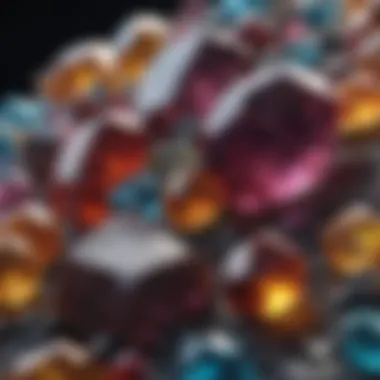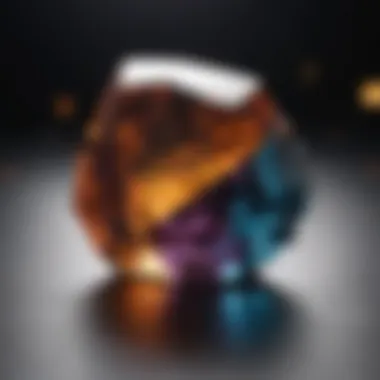Understanding Synthetic Gem Stones: A Deep Dive


Intro
In the modern realm of gemstones, synthetic gems have emerged as both a fascinating subject and a point of contention among enthusiasts, collectors, and educators alike. While the beauty and allure of natural gemstones are timeless, synthetic gems offer a different narrative with their own unique value proposition. One might ask what differentiates these creations from their naturally occurring counterparts beyond mere appearance. What ethical considerations come into play in this industry? As we delve into the complexities of synthetic gemstones, we aim to provide a detailed exploration that caters to both connoisseurs and casual admirers of gemology.
The journey begins with understanding the history and origins of synthetic gems, a tale woven through science and artistry. From the nuanced distinctions of identification to the methods of creation employed by various producers, each facet illuminates an intriguing aspect of this subject matter. This article will dissect how advancements in technology and shifts in consumer preferences have shaped the landscape of synthetic gemstones, culminating in what one might term a "gemological revolution."
As we peel back the layers, we will touch upon the social and economic implications of synthetic gemstones, not to mention the ethical considerations that have erupted in recent years. It’s not just about aesthetics anymore; it’s about understanding the entire framework in which these gems exist. So, let's embark on this enlightening quest, laying the foundation for deeper discussions that follow.
Intro to Synthetic Gem Stones
The world of gemstones has always intrigued people, with a history both rich and varied. Nevertheless, recent advances have added a twist to the tale: synthetic gem stones. These creations, though not found in nature, hold a significant place in jewelery and gemology today. Understanding the intricacies of synthetic gems is essential for enthusiasts and collectors alike. Given that many collectors often grapple with distinguishing between natural and synthetic gems, having a firmer grasp on the topic is critical.
Definition and Characteristics
To start, synthetic gem stones are crafted in laboratories but possess the same physical and chemical properties as their natural counterparts. A notable feature here is the way they mimic nature. For instance, lab-created diamonds, such as those produced by companies like Diamond Foundry, are virtually indistinguishable from natural diamonds when tested under standard conditions.
- Key Characteristics:
- Composition: The atomic structure mirrors that of natural stones.
- Appearance: Often, they exhibit fewer inclusions or flaws, boasting a higher clarity.
- Sustainability: Many are produced using eco-friendly techniques, appealing to the environmentally conscious collector.
These gems carry their own allure, often allowing for more intricate designs and superior quality without the environmental toll typically associated with mining.
Historical Context
The concept of creating synthetic gemstones dates back over a century. In the 19th century, the first synthetic gem was created when alumina and lime were fused to form sapphire. The excitement around synthetic gems grew exponentially after that, especially during the 20th century when advancements in chemistry and technology allowed for more sophisticated synthesis methods.
- Key Historical Milestones:
- 1840: First synthetic rubies created by chemist N. L. W. Bœgm.
- 1950s: Launch of high-quality lab-grown diamonds became a reality.
- 1970s: Japanese companies advanced techniques further, setting the stage for today’s industry.
Through the years, the acceptability and prestige of synthetic stones surged, shifting perceptions about their worth and longevity. Understanding this historical backdrop is crucial; it highlights the evolution of synthetic gems and prepares collectors to engage with modern-day practices in a more informed manner.
"Synthetic gemstones open a new chapter in the story of gemstones, reflecting innovation amidst tradition."
In summary, comprehending synthetic gemstones involves not just knowledge of their innate qualities but also an appreciation for the journey they have taken within the world of gemology. This foundation sets the stage for a deeper exploration in subsequent sections, illuminating various facets that differentiate these marvels from their natural cousins.
Comparative Analysis with Natural Gemstones
When delving into the realm of gemstones, one cannot simply ignore the significant differences between synthetic and natural varieties. This comparative analysis is crucial because it enlightens enthusiasts about not only the qualities of each type but also the underlying factors that contribute to their unique identities. By dissecting aspects such as composition, physical characteristics, and market values, collectors can make informed choices that align with their values, aesthetics, and investment goals.
Composition and Structure
Composition defines the essence of any gemstone. Synthetic stones are often made in labs using methods that mimic the natural processes of formation. For instance, while natural sapphires might take millions of years to form within the Earth’s crust, synthetic sapphires can pop out in a matter of weeks through processes like the Verneuil or Czochralski methods.
A key takeaway here is that the chemical makeup of synthetic sapphires—comprised of the same aluminum oxide—can be indistinguishable from their natural counterparts at a basic level. However, techniques like spectroscopy can reveal subtle differences in their structural integrity. Some collectors prefer natural stones due to their geological history, while others appreciate the flawless quality often found in lab-grown variants.
Physical Properties
Physical properties offer yet another layer of comparison. Both types may boast equivalent hardness on the Mohs scale. However, synthetic gems often exhibit fewer inclusions and impurities. This attribute can make them visually appealing, but it also pops the question: does flawlessness detract from the gem's story? Naturally occurring gemstones often possess unique defects, a manifestation of their time spent in nature, which can add character and authenticity to a collection.


Potential buyers should also note that physical reactions differ slightly under certain conditions. Natural stones may enhance their color under UV light more vibrantly than their synthetically made kin. Yet in terms of durability and hardness, man-made gems hold their own—sometimes even performing better under stress.
Market Value Differences
When we move our discussion to market values, the chasm between natural and synthetic stones widens. Generally, natural stones command higher prices due to their rarity. A natural diamond, for instance, can reach astronomical values that reflect not only its beauty but also its historical and geological narratives. Conversely, synthetic diamonds, while visually comparable, are often available for a fraction of the price. This price disparity translates to a complex investment landscape for dealers and collectors alike.
"Natural stones are investments wrapped in stories; synthetic stones present a different kind of value—affordability and accessibility."
Those who wish to invest strategically in gemstones should consider whether the price tag reflects ones’ values—whether that be the thrill of rarity or the pursuit of perfect beauty.
Ultimately, understanding these differences not only augments the collector's knowledge but also helps craft a personal narrative—choosing the right gemstone for the right purpose becomes a more thoughtful endeavor.
Production Methods of Synthetic Gem Stones
The production methods of synthetic gem stones serve as a pivotal component in understanding their creation and the value they hold in the gem market. Whether it is about aligning with consumer values or achieving a specific aesthetic, the techniques utilized in producing these gems are critical. This section will explore three principal methods—seeded growth, melt growth, and hydrothermal synthesis—providing insights into their processes, advantages, and the considerations they entail.
Seeded Growth Techniques
Seeded growth techniques have been around for quite some time, laying the foundation for producing various types of synthetic gems. Essentially, this method involves using a small crystal or “seed” to facilitate the growth of a larger gem. The seed acts as a template, promoting the orderly arrangement of atoms as materials are added.
One popular form of seeded growth is the Czochralski process. This process begins by melting a suitable gemstone material and then slowly pulling a seed crystal from the liquid. The result is a gem with a uniform composition and structure.
Advantages of Seeded Growth:
- Quality: The quality of crystals is generally high, making them visually appealing.
- Control: There’s a high degree of control over the gem’s properties, allowing for customization.
However, it’s not all sunshine and rainbows. The costs associated with precision equipment can be steep, which might make the end product pricier than expected.
Melt Growth Techniques
Melt growth techniques embrace a more direct approach to gem synthesis. This method involves melting the raw materials that make up the desired gem and allowing them to solidify into a crystal. A commonly known example is the Verneuil process, where a fine powder of the gemstone material is melted and then crystallized as it cools.
The appeal of melt growth mainly lies in its efficiency and lower production costs. It allows for a quicker turnaround, which is an attractive consideration for manufacturers looking to meet market demands.
Pros of Melt Growth Techniques:
- Cost-Effective: Typically, this method requires less initial investment.
- Rapid Production: These techniques can produce gems in a relatively short amount of time.
Nonetheless, there is a trade-off. The quality of gems produced might not always match up to those made through seeded methods, leaving some collectors wary of their investment.
Hydrothermal Synthesis
Hydrothermal synthesis mimics the natural conditions under which crystals form deep within the Earth. By using a high-pressure environment and a solvent to dissolve the raw materials, this technique supports the growth of crystals over time.
This method is particularly attractive for producing amethyst, emerald, and ruby. The stones created through hydrothermal processes can be remarkably close in appearance to their natural counterparts, making them a desirable choice for many jewelers.
Benefits of Hydrothermal Synthesis:
- Authenticity: The process can create gems that are nearly indistinguishable from those mined from the earth.
- Sustainability: This technique often has a lower environmental impact due to reduced mining needs.


Still, while this method has its upsides, the time required for crystal growth can be extensive, creating a bottleneck in production.
"In the world of synthetic gem production, the method chosen often reflects the intricate balance between cost, time, and the desired quality of the final product."
Each of these methods has its merits and drawbacks, influencing both the characteristics of the gems produced and their standing in the market. Understanding these techniques provides a valuable insight into the synthetic gem landscape.
Ethical Considerations in Synthetic Gem Production
In recent years, the ethical implications of synthetic gem production have taken center stage. With awareness of issues such as conflict diamonds and exploitative mining practices on the rise, discerning consumers are keenly interested in how their gems are produced. For those deeply entrenched in the field of gemology, understanding the ethical landscape is not just about making informed purchases; it is about shaping the future of the industry itself.
Conflict-Free Certification
One of the paramount concerns for many buyers is the assurance that their purchased gemstones are conflict-free. This term refers not just to diamonds but extends to all gems cultivated under conditions that are free from human rights violations and warfare. The Kimberley Process was initially designed to keep conflict diamonds out of the market, and similar frameworks have begun to take shape for other stones. However, these certifications can often be murky. It’s crucial for consumers and collectors alike to be vigilant and demanding when it comes to tracing the origin of synthetic gems.
When a supplier claims that a gem is certified conflict-free, it essentially assures that the material was sourced under ethical conditions. But what does this really mean on the ground? In practice, it might be complicated.
- First, many synthetic producers must navigate a web of certifications that can differ widely in reliability. Not all certifying bodies have the same standards, and due diligence is necessary.
- Second, just because a gemstone is labeled as conflict-free does not inherently guarantee fair labor practices in its production. Buyers must dig deeper, not just into origin but into the entire supply chain.
- Finally, the growing demand for transparency has led to an increasing number of producers responsibly marketing their conflict-free certifications. This transparency benefits not just the consumers but also ethical miners and gem growers who do adhere to fair practices.
"The journey of a synthetic gem does not end with its creation, but continues through its certification. Buyers must imagine the journey each gem takes, from genesis to their possession."
Environmental Impact
Another pressing ethical consideration revolves around the environmental implications of synthetic gemstone production. Contrarily to mining natural gemstones, which can wreak havoc on landscapes and ecosystems, synthetic production carries its own set of challenges. While many argue that creating gems in a lab minimizes ecological destruction, there are essential factors to consider.
- Resource Consumption: The energy required for creating synthetic gems can be substantial, particularly for processes like Hydrothermal synthesis. It’s important to investigate the source of this energy, as reliance on fossil fuels can negate the environmental benefits.
- Waste byproducts: The production of synthetic gems can lead to waste generation. Chemical processes sometimes release materials that, if not treated correctly, can be harmful. Transparency from manufacturers regarding their waste management practices can greatly enhance their credibility.
- Sustainable Practices: Some producers are responding to the demand for eco-friendly gems with innovative solutions. Technologies that harness renewable energy and recycling of materials have surfaced. Those interested in synthetic gems should inquire about how a company is addressing the environmental challenges and what sustainable practices it has in place.
As the discourse around synthetic gemstones evolves, ethical considerations remain at the forefront. Collectors and enthusiasts are increasingly driven to seek gems that not only boast beauty but also align with their values on ethics and environmental sustainability. Understanding these dynamics will certainly reshape consumer expectations and market behaviors in the future.
Market Trends in Synthetic Gem Stones
The realm of synthetic gemstones has transformed in recent years, and understanding the market trends is vital for anyone involved in the industry or passionate about gemology. As synthetic gems carve their niche within the larger gemstone market, different aspects emerge that make this topic worthy of attention. For enthusiasts, collectors, and investors, grasping these trends offers both strategic advantages and knowledge of evolving preferences.
Consumer Preferences
Consumer preferences have shifted remarkably over the years, thanks mainly to the increasing awareness about sustainability and ethical production. Many buyers, particularly millennials and Gen Z, prioritize gemstones that do not contribute to conflict or environmental degradation. This has generated a rising demand for synthetic gemstones, which effortlessly fulfill such desires. These individuals often see synthetic stones not just as substitutes, but as ethically sound choices that provide the same beauty without the baggage.
For instance, an engagement ring made with a synthetic diamond often comes with a story to tell about responsible sourcing. People are drawn to brands that openly discuss their production methods, highlighting the commitment to transparency. Moreover, the allure of customization is also strong—many consumers appreciate the ability to select colors and styles unique to their tastes. This brand loyalty and emotional connection fostered through ethical narratives often trump the allure of natural stones.
"In the eyes of many consumers, synthetic gems hold a unique charm; they represent progress, innovation, and above all, choices."
Market Growth Rates
The market for synthetic gemstones is on an unmistakable upward trajectory. Considerable research indicates a compound annual growth rate (CAGR) that consistently outpaces natural stones across various segments. Factors contributing to this rise include enhanced technology, improving quality of synthetic gems, and their increasing acceptance in mainstream jewelry trends.
In 2022, the global synthetic gem market was estimated to be worth around $20 billion, with projections suggesting it could reach $60 billion by 2030. As platforms for consumer education expand, awareness grows as well. Many retailers now incorporate synthetic stones into their offerings, reflecting increasing consumer acceptance. Industry players are learning to adapt their strategies to accommodate this shift. Key participants, from local artisans to large-scale manufacturers, are adjusting their inventory to keep pace with consumer demands.
The market growth rates are bolstered by affordability too; synthetic stones often cost significantly less than their natural counterparts while providing superior traits such as clarity and size. This makes them particularly appealing for those looking to invest in exquisite pieces without breaking the bank. As price consciousness merges with a growing ethical consciousness, the future looks bright for the synthetic gem industry.
Challenges in the Synthetic Gem Market


The synthetic gem market has flourished in recent years, but it isn't without its bumps along the way. Two primary challenges arise here, affecting both perception and regulation. Understanding these hurdles is crucial for enthusiasts and collectors alike as they navigate the nuanced layers of this fascinating field.
Perception Issues
One cannot underestimate the role of perception in the gem industry. Synthetic gemstones, despite their growing popularity, often battle an uphill fight against public opinion. Many collectors and consumers still hold a preference for natural stones, often equating authenticity with value. The notion that man-made means lesser can be a tough nut to crack.
Interestingly, historical biases against synthetic gems linger, rooted in their earlier iterations which were often seen as inferior. These stones sometimes fell prey to misconceptions that they lack the beauty and uniqueness of their natural counterparts.
To address these perception issues, industry players are venturing into educational campaigns aimed at demystifying synthetic gemstones. Emphasizing their durability, ethical production, and affordability are key points that can help shift opinions.
"Understanding creates appreciation. When consumers learn about the quality behind synthetic gems, they might just reconsider their initial biases."
Additionally, as more celebrities and influencers flaunt synthetic stones, there's a slow but noticeable shift in the conversation. The trick is to encourage this narrative while building credibility around the authenticity of synthetic gems.
Regulatory Hurdles
Navigating the regulatory landscape can be akin to walking through a minefield. Regulatory standards vary widely across countries and regions, leading to inconsistencies in how synthetic gemstones are classified and labeled. In certain jurisdictions, there exist strict guidelines regarding the disclosure of whether a gem is synthetic or natural, while in others, such transparency isn't mandated. This not only complicates the marketing for synthetic gems but creates confusion among consumers.
Moreover, there’s an ongoing debate about the necessity of a universal standard for synthetic gems. Without one, businesses operate in a somewhat murky environment where ethical production and marketing practices may not be uniformly enforced. This can open the doors to fraud, with some unscrupulous dealers aiming to cash in on the burgeoning interest in synthetics.
In response, organizations within the industry are advocating for clearer regulations that protect both consumers and reputable dealers. Standards that ensure clarity around the distinctions between synthetic and natural could certainly foster trust and, ultimately, lead to wider acceptance.
Future Prospects of Synthetic Gem Stones
As the gemology landscape evolves, the future of synthetic gemstones stands to make significant waves. The topic of synthetic gem stones is not merely academic; it holds concrete relevance for both collectors and industry players. The progression within this field highlights technological advances, shifts in consumer attitudes, and the overarching implications for the gem market. In understanding these prospects, one can observe how synthetic gems may not only coexist but potentially overshadow their natural counterparts.
Technological Innovations
To grasp the future trajectory of synthetic gemstones, one must consider the technological innovations propelling their growth. New methods of production, like the improvements in hydrothermal synthesis, allow for higher-quality gems to reach the market at more competitive prices. For instance, advancements in the precision of Czochralski and Bridgman techniques enable gem creators to duplicate rare and valuable gemstones with remarkable accuracy, often indistinguishable from natural stones to the naked eye.
Furthermore, the emergence of 3D printing technology has begun creating gem-like materials with customizable characteristics, opening up a realm of personalized options for consumers. Such innovations not only increase the availability of synthetic gems but also challenge the traditional notions of craftsmanship and rarity that have stood the test of time in the gem industry.
"The marvels of technology are reshaping what we consider precious."
- A thought for every gem enthusiast to ponder.
Shifts in Consumer Awareness
The consumer landscape is also undergoing seismic changes. Awareness around the ethical implications of gemstone mining has grown significantly over recent years. More buyers now prefer conflict-free options, pushing synthetic stones into the limelight. For many rock and fossil collectors, synthetic gemstones present an attractive alternative, as they often come with verified origin stories, reassuring consumers who are wary of exploitation in the natural gem market.
Also, the marketing strategies employed by synthetic gem producers are pivoting. They're not just selling a product, but a concept: that beauty does not need to come at the cost of ethical considerations. This is essential as younger consumers, especially Millennials and Gen Z, prioritize sustainable and responsible purchasing decisions.
Culmination
In wrapping up the extensive exploration of synthetic gem stones, it's crucial to acknowledge the multifaceted nature of this topic. The discussion on synthetic gems delves into not just their allure, but also their growing relevance in today’s gemology landscape. Making sense of their value lies in understanding the balance between beauty, morality, and market dynamics.
Summary of Key Insights
The journey through this article highlights several notable insights:
- Composition and Structure: Synthetic gems mirror their natural counterparts with similar physical and chemical properties. This is key for collectors and enthusiasts who value authenticity.
- Production Techniques: Techniques such as hydrothermal synthesis and melt growth techniques illustrate the sophisticated methodologies that make production both intricate and fascinating.
- Ethical Considerations: As conversations around sustainability and ethical sourcing grow, synthetic gems present a conflict-free alternative, challenging traditional views held by many collectors.
- Market Trends: The inclination towards synthetic gemstones among consumers signals a shift in preferences, emphasizing value, ethics, and quality over the allure of scarcity associated with natural stones.
- Future Outlook: The advances in technology hint at exciting prospects, paving the way for potential innovations that further elevate synthetic gems' place in the market.
Final Thoughts on Synthetic Gems
Looking forward, as we navigate this evolving landscape, it’s vital for collectors to embrace the narrative surrounding synthetic stones. They are not merely replicas; they are products of advanced technology and intentional craftsmanship. Embracing synthetic gems allows collectors to support ethical practices while still indulging in the beauty and brilliance of gemstones.



